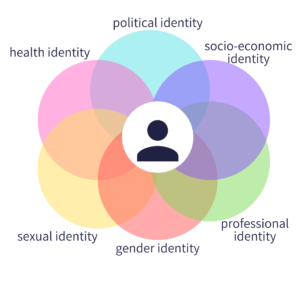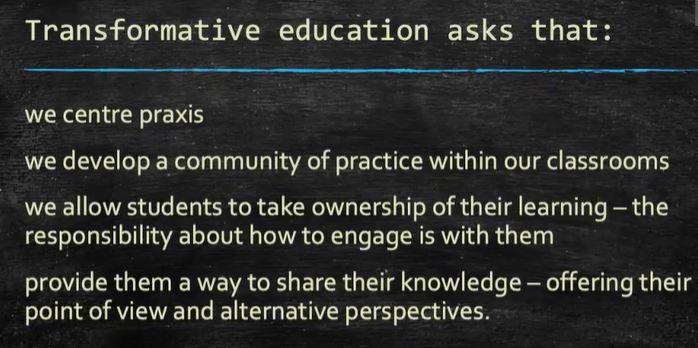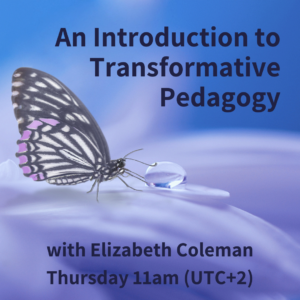We were really fortunate to have Elizabeth Coleman join us for this webinar on transformative pedagogy. It was a new term for me and it has nothing to do with butterflies! We started off with a trip down memory lane, thinking about our own experiences in education: enjoyable, difficult and memorable were some of our ideas. Elizabeth’s colleagues had said competitive, challenging, eye-opening, character-building and one poor person said painful!
Once upon a time…
Teachers taught with the didactic method in which the cognitive function is attaining basic knowledge. We have to meet specific educational goals and we develop basic skills. There is absorption and memorisation, with a very teacher-centred approach and passive students.
Over time, we’ve moved to centred students more in the learning process. The first step along from the didactic method is towards authentic learning: a contructivist approach with a focus on real-world learning. Because there is more of a link to the real world, knowledge comes through experience rather than memorisation. There is also space for different perspectives as opposed to just the teacher being the source of input.
We went on to think about what our learners need: support, space to question, permission to make mistakes – a safe space is vital for all of us to thrive. Again, Elizabeth had asked her colleagues as well and some of their ideas included enthusiasm, passion, a stimulating environment and easy exam questions!
Transformative Pedagogy
It’s someting which we might have been practising for a while without knowing what it was called. It’s a very humanist approach, seeing learners as individuals within the world.
It allows us to think about the affective factors in the classroom and our learners’ intersectional identities: all the components of yourself overlap.

It’s a great methodology to tackle -isms as it’s anti-discrimination and is an equitable approach, allowing each person to receive what they need to get them to the same place. Recognising each learners’ identity is very empowering, giving learners much more of a voice and place in the classroom.
Paolo Freire wrote about these ideas in The Pedagogy of the Oppressed, which was first published in 1968. One of his main ideas was a criticism of the ‘banking’ model of didactic learning with the student as an empty vessel to be filled by the teacher. He said that this model “transforms students into receiving objects [and] attempts to control thinking and action, leading men and women to adjust to the world, inhibiting their creative power.”
This move towards a deeper cognition liberates learners to think more freely, rather than simply absorbing information. It allows everyone to become a learner, as we all learn from each other as a part of the process. And, as the approach allows for criticism and critique, we can tackle oppression, debate and challenge the status quo (if you’re in an environment where you have the freedom to do so and your learners are comfortable to do so).
However, although Freire introduced these ideas fifty years ago, we haven’t seen a huge amount of change in education. We still use a number of ‘old-school’ methodologies and the materials we use don’t see our learners as individuals.
There are still so many educational systems which rely on these methodologies and although we are hearing about some changes, for example in Scandinavian countries, there’s still a lot of room for improvement.
Education as a force for good
Transformative pedagogy has also been called an activist pedagogy as it seeks to help those who need it. It also draws on ideas which aren’t necessarily seen in materials; for example, we might start to think more about the background of the character in the coursebook: who is he? What’s his educational, professional or socio-economic identity? Does he have any health conditions which prevent him from doing certain things? As well as seeing our learners as whole beings, we can make the people on the page multi-dimensional too.

To get started, let your learners know that they can take control in the classroom by giving them supportive feedback and a safe place to make mistakes and take decisions.
Allow them to teach each other as well – perhaps even in their L1 if learners share a first language. They can teach things about ELT, but also allow them the space to share their interests.
Allow them to debate, discuss and share their opinions as well.
Ask critical questions to make them think.


1 thought on “An Introduction to Transformative Pedagogy”